Steel Stamping Advancements: Elevating Production Processes for Superior Outcomes
In the realm of making processes, metal stamping has actually long been a cornerstone strategy for generating a selection of accuracy elements. With the relentless march of technical innovation, the landscape of steel stamping is going through a significant makeover.
Evolution of Steel Stamping Techniques

Additionally, improvements in material scientific research have actually resulted in the growth of high-strength alloys that can currently be effortlessly marked right into detailed forms, providing to a broader array of commercial applications. The assimilation of robotics and expert system has actually even more optimized the stamping process by improving rate and precision while reducing the danger of human error.

Influence of Advanced Materials
Have advanced products transformed steel stamping procedures substantially in the manufacturing market? By using products such as high-strength alloys, progressed compounds, and cutting-edge coatings, metal marking processes can currently generate parts that are lighter, stronger, and a lot more sturdy than ever previously.
These sophisticated materials offer superior mechanical residential properties, rust resistance, and thermal stability, permitting makers to meet the demands of contemporary industries such as aerospace, auto, and electronics. In addition, making use of advanced materials in metal stamping has actually assisted in the manufacturing of complicated geometries and elaborate layouts that were previously unattainable via standard techniques.
Additionally, the execution of advanced materials has led to decreased product waste, lower manufacturing expenses, and shorter preparations, making metal marking processes much more economical and sustainable. As technology remains to breakthrough, the impact of sophisticated products on steel marking procedures is expected to drive further innovation and improve the competitiveness of manufacturers in the global market.
Automation in Steel Stamping
The advancement of metal marking procedures driven by the assimilation of advanced products has set the phase for considerable improvements in automation within the production market. Automation in steel marking has actually revolutionized manufacturing procedures, enhancing effectiveness, precision, and total result quality. Through the application of robotics, sensors, and computer-controlled systems, jobs that were taxing and as soon as manual can currently be executed with unequaled speed and precision.
Automation in steel marking not only accelerates production prices however likewise guarantees consistency in the production procedure. By lessening human treatment, the risk of errors is significantly reduced, causing greater levels of product harmony and dependability. In addition, automation enables suppliers to undertake complex marking tasks that would be tough or unwise to attain manually.
Additionally, automation in metal stamping contributes to a safer working setting by reducing the need for staff members to engage in hazardous or repetitive jobs - Metal Stamping. This shift in the direction of automation not only enhances productivity yet also leads the means for the future of production, where technology plays a central duty in driving functional quality
Top Quality Control and Evaluation Solutions
With a concentrate on accuracy and dependability, quality assurance and examination systems play an essential duty in making certain product quality in steel stamping procedures. These systems are developed to monitor every stage of manufacturing, from material examination to the end product, to guarantee that all components meet the needed requirements. By implementing innovative innovations such as optical evaluation systems, coordinate determining makers (CMM), and automated evaluating devices, producers can discover also the smallest inconsistencies in dimensions, surface quality, and total integrity of stamped components.

Sustainability Practices in Metal Stamping
Structure upon the foundation of accuracy and reliability established through quality assurance and inspection systems, the assimilation of lasting techniques in steel right here stamping processes is significantly ending up being a focal point for manufacturers seeking to reduce ecological influence and maximize resource application. Sustainability techniques in steel stamping encompass a range of initiatives focused on reducing waste generation, power consumption, and greenhouse gas emissions throughout the production process.
One key facet of sustainability in steel stamping is the fostering of green materials and technologies that promote recyclability and waste decrease. By utilizing recycled materials and applying energy-efficient equipment, manufacturers can reduce their carbon impact and contribute to a more sustainable production cycle. Furthermore, enhancing manufacturing procedures to decrease product waste and power usage not only profits the environment but also brings about set you back financial savings for organizations in the future.
In addition, the execution of sustainable techniques in metal marking can boost brand name track record and attract environmentally mindful customers. As sustainability remains to gain relevance in the production industry, integrating environment-friendly campaigns right into steel stamping procedures is important for long-lasting success and competitiveness in the marketplace.
Final Thought
To conclude, metal stamping methods have actually dramatically evolved over time, incorporating innovative products and automation to improve manufacturing processes. Quality assurance and inspection systems play a vital role in ensuring remarkable results, while sustainability methods are progressively being executed to lower environmental impact. These developments in metal marking have actually changed the sector, resulting in a lot more lasting and effective manufacturing methods for different industries.
Steel stamping, once a handbook and labor-intensive process, has transformed into a very automated and sophisticated approach of forming steel sheets right into various types and styles.Have innovative products transformed metal stamping procedures dramatically in the manufacturing sector? By making use of materials such as high-strength alloys, advanced composites, and innovative coatings, metal marking procedures can now produce components that are lighter, stronger, and much more sturdy see this than ever in the past.
The development of metal marking processes driven by the combination of advanced materials has actually established the phase for significant innovations in automation within the manufacturing market.In final thought, steel more information stamping methods have dramatically advanced over time, integrating innovative products and automation to enhance manufacturing procedures.